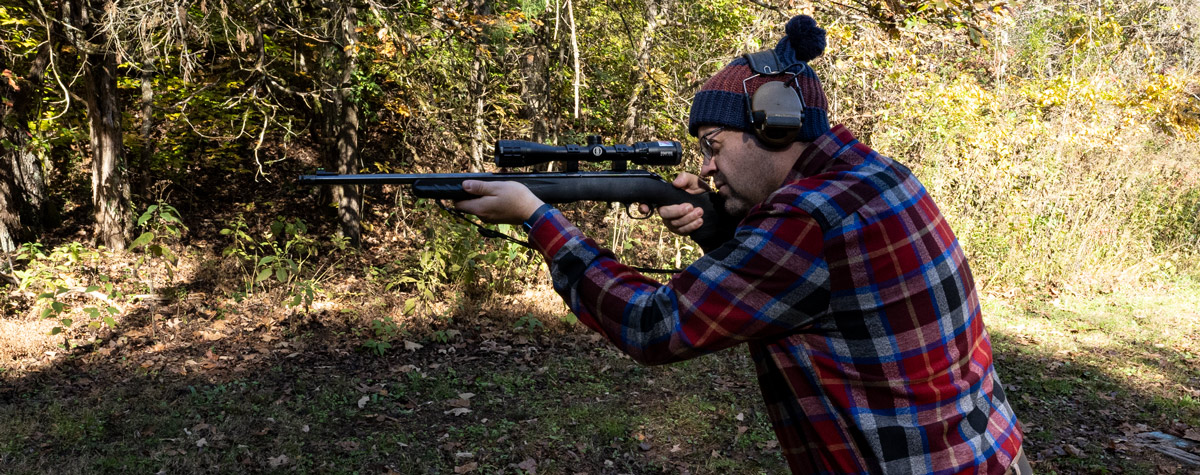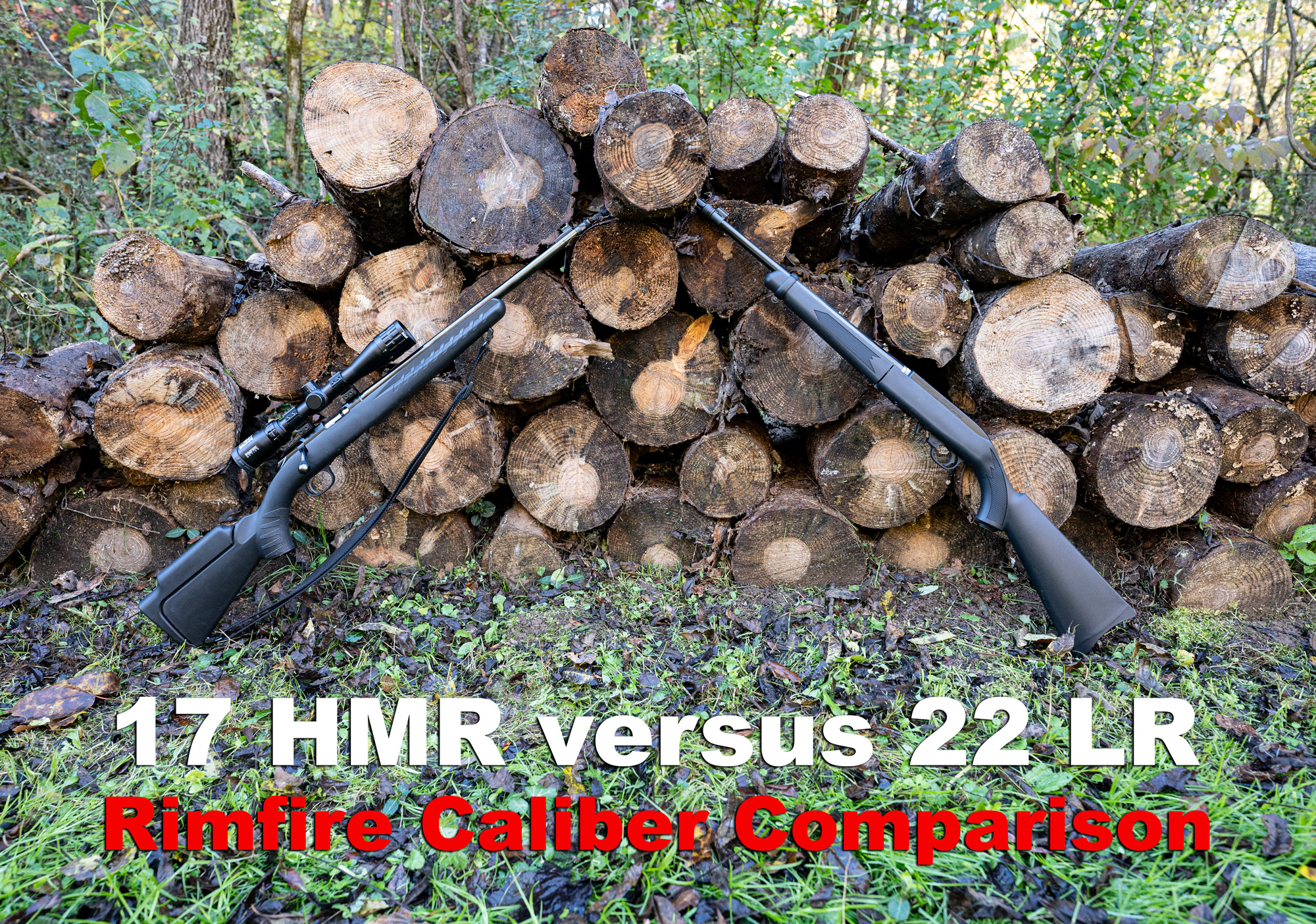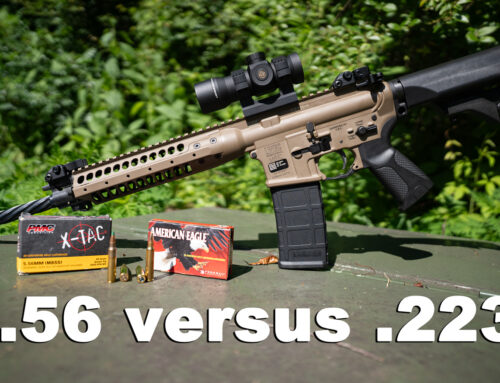Many rimfire primed cartridges have been introduced to the market over the past several decades, but very few are fired in any significant quantities. Among these are the 22 Long Rifle (22 LR) and the 17 Hornady Magnum Rimfire (17 HMR).
If you’re new to firearms, then you may wonder: How does the 22 LR and the 17 HMR compare to each other? And if one is objectively better than the other, then why do they coexist? We’re going to answer those questions by comparing these two rimfire rounds’ ballistic performance, stopping power, recoil and price tags. Read this article and you’ll understand each cartridge’s place perfectly!
Cartridge Dimensions

22LR ammo on the left next to 17 HMR ammo (right)
| 17 HMR | 22 LR | |
|---|---|---|
| Parent case | 22 WMR | 22 Long |
| Bullet diameter | 0.172 in | 0.223 in |
| Neck diameter | 0.190 in | 0.226 in |
| Shoulder diameter | 0.238 in | N/A |
| Base diameter | 0.238 in | 0.226 in |
| Rim diameter | 0.286 in | 0.278 in |
| Rim thickness | 0.050 in | 0.043 in |
| Case length | 1.058 in | 0.613 in |
| Overall length | 1.349 in | 1.000 in |
We don’t have to include these two rounds’ case capacities to point out the obvious difference between them: The 17 HMR is a much bigger cartridge! Its case’s significantly larger dimensions mean it can store more propellant, and accordingly put more energy behind its bullet.
The 17 HMR is a bottlenecked cartridge while the 22 LR isn’t. A bottleneck helps to focus the propellant gasses’ energy behind the bullet. This gives the 17 HMR’s projectile approximately double the muzzle velocity. The 17 HMR has got a smaller diameter bullet as the result of its narrower case mouth. Part of the reason it can attain such a higher velocity is its lighter weight.
It’s important to point out that neither of these rimfire cartridges are powerhouses by any measure. A rimfire primer’s design prohibits a cartridge from having very thick case brass. This, in turn, limits how much pressure the case can contain before it splits open. But we can safely expect a larger rimfire cartridge to achieve higher velocities all the same.
17 HMR vs 22: Ballistic Performance
To preface, let us note that our elevation data reflect test rifles with 1.5” scope heights. This does nothing to obscure the simple fact that the 17 HMR is the flatter-shooting cartridge.
Interestingly enough, the 17 HMR’s ballistic coefficient (a measure of the bullet’s ability to overcome air resistance in flight) is nearly always lower than that of the 22 LR (albeit by very little). This is the result of the 17 HMR’s significantly lighter bullet (17 or 20 grains as opposed to the 22 LR’s common 36 or 40 grains). A lighter bullet naturally retains less momentum, so its velocity (and energy) both decline more rapidly.
Velocity
But the 17 HMR’s lightweight bullet comes with a big blessing: speed. So fast a bullet is going to hug a laserlike trajectory throughout its effective range, and that’s precisely why the 17 HMR is able to facilitate such pinpoint accuracy up until around 200 yards. (Once the 17 HMR bullet becomes subsonic its accuracy turns to garbage, but plenty of hunters have pulled off kills at 250+ yards.)
The 22 LR’s trajectory doesn’t arch so dramatically that it becomes far more difficult to aim by comparison. But its bullet must rise significantly more in order to hit even a 100-yard target. The 22 LR’s effective range is also shorter than its competitor at 150 yards. (Bearing in mind that you’ve got to be a somewhat competent shooter to appreciate the 17 HMR’s accuracy advantage beyond 150 yards.) In short, if accuracy is all you want from your next rimfire rifle, the 17 HMR has everything going for it.
Stopping Power/Energy
The phrase “stopping power” encompasses many aspects of a cartridge’s terminal performance. These aspects include penetration depth, wound channel diameter, and potential for expansion. We would normally take these several factors into account while comparing two self-defense cartridges’ stopping power.
While the 22 LR and 17 HMR are both occasionally used for personal protection, they are vastly more popular for varmint hunting. Since your life probably won’t be at risk unless you can neutralize a ground squirrel as quickly as possible (unless it’s one heck of an angry ground squirrel), we’re only going to compare these two cartridges’ impact energy. To do this, let us average how much energy each round compared above retains at 25 yard increments.
| 17 HMR | 22 LR | |
|---|---|---|
| Muzzle energy (ft lbs) | 236 | 132 |
| Energy @ 25 yds | 206 | 116 |
| Energy @ 50 yds | 179 | 104 |
| Energy @ 75 yds | 155 | 95 |
| Energy @ 100 yds | 133 | 88 |
| Energy @ 125 yds | 114 | 82 |
| Energy @ 150 yds | 98 | 77 |
| Energy @ 175 yds | 84 | 72 |
| Energy @ 200 yds | 71 | 68 |
The 17 HMR’s energy advantage is unmistakable. At 50 yards it inflicts 72% more energy; at 100 yards, about 50% more energy. The 17 HMR will undoubtedly deal more damage to a varmint throughout its effective range. Furthermore, because the 17 HMR may be loaded with a polymer tipped bullet that bursts into fragments upon impact, while the best a 22 LR cartridge can offer is a traditional hollow point that may not retain the energy it needs to expand at all, the 17 HMR is poised to deal a far more devastating injury to its target.
Is this to suggest the 22 LR is inadequate for varmint hunting? Not at all, but it’s easy to appreciate why coyote and other predator hunters may completely eschew the 22 LR in favor of a more powerful round like the 17 HMR.
17 HMR vs 22 Recoil

Low recoil is always preferable. It makes hunting and target shooting less tiresome. It also decreases the amount of time you have to spend lining up each subsequent shot.
We cannot promise how much recoil you’ll actually notice after you’ve squeezed the trigger. That’s purely subjective! But we can objectively measure the recoil energy of the 22 LR and 17 HMR cartridges compared earlier by taking four factors into consideration: muzzle velocity, bullet weight, propellant weight and firearm weight. For the sake of this comparison let’s assume all 22 LR rounds have 2 grains of powder, all 17 HMR rounds have 5.5 grains, and both test rifles weigh 5 pounds.
| Recoil Energy (ft lbs) | |
|---|---|
| CCI Mini-Mag 22 LR 36gr CPHP | 0.19 |
| Federal 22 LR 40gr LRN | 0.21 |
| 22 LR Aguila 40gr CPHP | 0.23 |
| 17 HMR Hornady Varmint Express 17gr V-MAX | 0.32 |
| 17 HMR CCI 17gr FMJ | 0.29 |
| 17 HMR CCI 20gr FMJ | 0.36 |
The 17 HMR’s energy advantage is unmistakable. At 50 yards it inflicts 72% more energy; at 100 yards, about 50% more energy. The 17 HMR will undoubtedly deal more damage to a varmint throughout its effective range. Furthermore, because the 17 HMR may be loaded with a polymer tipped bullet that bursts into fragments upon impact, while the best a 22 LR cartridge can offer is a traditional hollow point that may not retain the energy it needs to expand at all, the 17 HMR is poised to deal a far more devastating injury to its target.
Is this to suggest the 22 LR is inadequate for varmint hunting? Not at all, but it’s easy to appreciate why coyote and other predator hunters may completely eschew the 22 LR in favor of a more powerful round like the 17 HMR.
Here’s the important conclusion: Comparing two rimfire cartridges’ recoil energy is an exercise in splitting hairs. The 17 HMR does generate about one-third more recoil energy. However, the difference so miniscule that you won’t even notice it – not to mention that less than 1 ft lb of recoil energy is hardly perceptible in the first place!
17 HMR vs 22 Price & Availability
Here’s where the 22 LR truly outshines its competition. It is the most popular cartridge in the world, full stop. This is partly due to misguided foreign governments limiting which types of ammunition their citizenry can access. It’s also attributable to the 22 LR’s low price (which itself is because to its small size), gentle recoil, and soft report.
Barring some cataclysmic ammo shortage, the 22 LR ammo is always available from several manufacturers and with any bullet style: LRN (lead round nose), CPRN (copper plated round nose) or CPHP (copper plated hollow point). 22 LR pistols and rifles, which are highly popular for hunting, plinking and target shooting, ought to fill any gun store’s glass counters to the brim.
17 HMR ammunition and the firearms chambered for it are not too scarce. You will find either with minimal effort, but both are going to be significantly more expensive by comparison. The 17 HMR cartridge itself isn’t just more expensive because it is larger – its bullet also costs more to manufacture, because it requires at least an FMJ (full metal jacket) instead of a more cost-effective LRN.
The Big Takeaway
If you’re just looking for a simple range toy or a casual solution for rodents that have gotten a little too familiar with your bird feeder, you are going to make your life a whole lot easier by opting for the omnipresent 22 LR. It’s cheap, it’s accurate enough for a novice to hit 100-yard targets, and it deals more than enough damage to finish any American rodent.
But if you’re looking to enhance your accuracy and don’t mind spending a little more time sourcing ammo, then you might find the 17 HMR’s higher price tag well worth it. This round lets you reach 100 yards much more easily than the 22 LR. You can easily double that range with some practice. The 17 HMR’s higher impact energy throughout its entire effective range also makes it great for coyote within 100 yards. A 22 LR can fell a canine too. However, it’s not quite reliable enough to do the trick without risking a lot of pain and suffering on the yote’s part.
So, in the 17 HMR vs 22 debate, there are clear reasons to opt for each over the other. Now you’re armed with the facts – good luck out there!






Leave A Comment